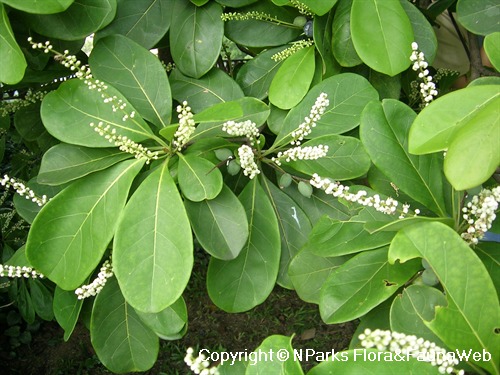_lowres.jpg)
Back
Terminalia procera Roxb.
| Family Name: | Combretaceae |
| Synonyms: | Terminalia copelandii Elmer, Terminalia crassiramea Merr., Terminalia gigantea Sloot., Terminalia catappoides C. T. White & Francis ex Lane-Poole |
| Common Name: | Ketapang, Ketapang Darat, Talisai Paya |
Name
Classifications and Characteristics
| Plant Division | Angiosperms (Flowering Seed Plants) |
|---|---|
| Plant Growth Form | Tree |
| Lifespan (in Singapore) | Perennial |
| Mode of Nutrition | Autotrophic |
| Plant Shape | Tiered |
| Maximum Height | 40 m |
Biogeography
| Native Distribution | Peninsular Malaysia, Sumatra, Borneo, Philippines, Indonesia, New Guinea. |
|---|---|
| Native Habitat | Terrestrial |
| Preferred Climate Zone | Tropical |
| Local Conservation Status | Non-native |
Description and Ethnobotany
| Growth Form | It is a large tree, up to 40 m tall, with grey or brown bark. |
|---|---|
| Foliage | Leaves are spirally arranged on the branch. They are obovate shaped (15 – 40 cm long and 4.5 – 18 cm wide) with 24 – 30 pairs of lateral veins which are almost perpendicular to the midrib. The upper surface of the leaf is glossy while the underside is sparsely hairy (pubescent) and sometimes minutely warty (verrucose). The leaf tip is rounded while the leaf base is subcordate. Domatia are present but inconspicuous. The leaf stalk (petiole) is 0.5 – 1cm long. Both the leaf stalk and young leaf are hairy at first and gradually becoming glabrous as they mature. |
| Flowers | Flowers occur in a cluster as a spiked inflorescence at axillary position. Inflorescence is 25 – 50 cm long, and comprises of numerous white to cream coloured flowers. |
| Fruit | Fruit is variable, about 3.5 – 6 cm long and 2.2 – 3 cm wide. Its shape ranges from ovoid, ellipsoid, to obscurely 5-lobed. It has sparse appressed hairs or nearly smooth when mature. |
| Habitat | It is found in terrestrial forests up to 500 m altitude. |
| Associated Fauna | Flowers are pollinated by insects. |
| Cultivation | It can be propagated by seed. |
| Etymology | The genus Terminalia, in Latin, refers to the plant’s leaves that are clustered at the end of end of the twigs. |
| Ethnobotanical Uses | Edible Plant Parts : Edible Seeds Timber & Products: The timber is used to build houses, make canoe and veneer. Others: The kernels of the fruit are said to be edible. |
Landscaping Features
| Landscape Uses | Parks & Gardens |
|---|
Fauna, Pollination and Dispersal
| Pollination Method(s) | Biotic (Fauna) |
|---|
Plant Care and Propagation
| Light Preference | Full Sun |
|---|---|
| Water Preference | Moderate Water |
| Plant Growth Rate | Moderate |
| Rootzone Tolerance | Well-Drained Soils |
References
| References | Coode, M. J. E. (1973) Notes on Terminalia L. (Combretaceae) in Papuasia. Contributions from Herbarium Australiense, No 2, pp. 1 – 33. Exell, A.W. (1954). Combretaceae. In: G.G.G.J. van Steenis (ed.), Flora Malesiana, Ser. 1, vol 4, pp. 533–589. Djakarta: Noordhoff-Kolff. Lemmens, R.H.M.J., Soerianegara, I., and Wong, W.C. (Editors). 1995. Plant Resources of South-East Asia Volume 5 (2). Timber Trees: Minor commercial timbers. Indonesia: Prosea Foundation. 655 pages. |
|---|
Image Repository
Others
| Master ID | 32505 |
|---|---|
| Species ID | 6917 |
| Flora Disclaimer | The information in this website has been compiled from reliable sources, such as reference works on medicinal plants. It is not a substitute for medical advice or treatment and NParks does not purport to provide any medical advice. Readers should always consult his/her physician before using or consuming a plant for medicinal purposes. |

_lowres.jpg)
_lowres.jpg)

_lowres.jpg)

